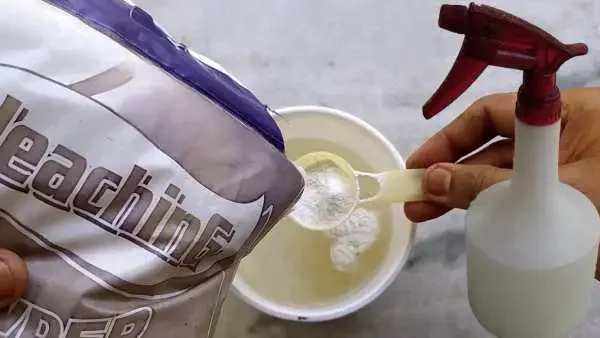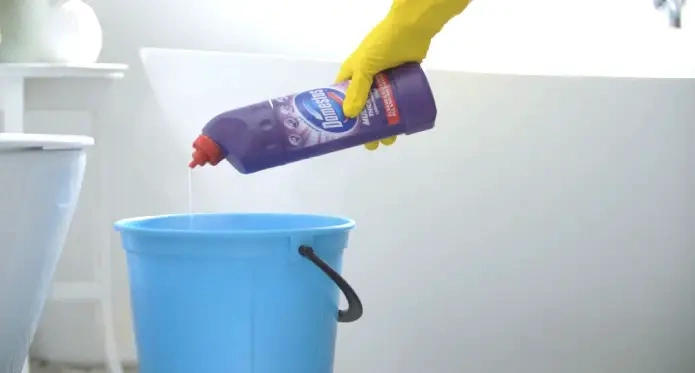Last Updated on November 14, 2023
When cleaning your toilet surfaces, bleach is a popular choice due to its powerful disinfecting and whitening properties. However, did you know that mixing bleach with certain substances can enhance its cleaning abilities and neutralize its strong odor?
You can mix plain water as a diluent to reduce bleach concentration and make it safer to use on toilets. Laundry detergent can be added to bleach for extra cleaning power, as it contains surfactants that help break down stains. You can also mix baking soda with bleach to remove tough stains and odors.
However, there are certain substances you should avoid mixing with bleach for any cleaning, including toilet surfaces, because these combinations can create toxic fumes. So keep reading to find out what you can and should not mix with bleach in the following paragraphs.
What Can I Mix With Bleach to Clean Toilet Surfaces Safely?

When cleaning your toilet with bleach, you should know what can be safely mixed with it for effective cleaning. Bleach can be mixed with:
- Plain Water
- Laundry Detergent
- Bicarbonate of Soda (Baking Soda)
Plain Water
Mixing bleach with water creates a milder disinfectant solution that is safe and commonly used for toilet cleaning. When combined, the water dilutes the bleach, making it less harsh while maintaining its effectiveness as a disinfectant.
This diluted bleach solution can also be used for general cleaning tasks around your home. Mix one cup of bleach with four liters of water to create a general-purpose toilet bleach cleaner. You can adjust this ratio according to the cleaning task at hand.
Make sure you wear protective gear when working with even diluted bleach. This includes gloves and goggles to protect your skin and eyes from any potential irritation or harm.
Also, ensure proper ventilation in the area where you are using the diluted bleach solution. Open windows or use fans to circulate fresh air and prevent any buildup of fumes. Make sure to keep pets and kids away when using bleach for cleaning.
Laundry Detergent
Adding a small amount of bleach to your laundry detergent can help brighten whites and remove stubborn stains from the toilet surfaces. Most laundry detergents already contain some form of bleach, but adding more can enhance the cleaning power.
Bleach works by breaking down the chemical bonds that hold stains and dirt to toilets, making them easier to remove. It also has disinfectant properties and can kill bacteria and viruses from toilet surfaces.
Before using bleach with laundry detergent, choose the right type of bleach for the job. Oxygen bleach should be used for colored toilets, while chlorine bleach suits whites.
Bicarbonate of Soda (Baking Soda)
Baking soda can be a versatile addition to your toilet cleaning routine. Combined with bleach, it can help brighten the toilet surface while neutralizing the odor of the strong bleach. Add half a cup of baking soda and half a cup of bleach to your white laundry during the washing cycle.
However, exercise caution when using this mixture on colored items as it may cause fading. The alkaline nature of baking soda helps enhance bleach’s cleaning power by increasing its pH level, making it more effective in removing stains and odors from toilets.
What should I not mix with bleach for cleaning?

When cleaning your toilet, certain substances should never be mixed with bleach, such as:
Vinegar and other Acidic Cleaners
Mixing bleach with vinegar or other acidic cleaners can produce highly toxic chlorine gas, which can cause a range of health issues.
Chlorine gas is a lung irritant that can damage the lungs and cause difficulty breathing. It can also cause skin burns and eye irritation upon contact. Inhaling chlorine gas may lead to coughing, chest pain, and vomiting.
Ammonia
Ammonia is a chemical compound that can cause serious respiratory problems when combined with bleach. You should never mix ammonia and bleach together, as this combination produces toxic chloramine gas. Inhaling this gas can result in breathing difficulties, chest pain, and other severe respiratory issues.
A mixture of ammonia and bleach creates chloramine gas, similar to mustard gas used as a chemical weapon during World War I. Mustard gas is highly toxic and can cause significant harm to the respiratory system.
Rubbing Alcohol (Isopropyl Alcohol)
Mixing rubbing alcohol and bleach is not recommended due to the potential health risks. Chloroform, a byproduct of this combination, can lead to breathing difficulties and even loss of consciousness.
Also, other harmful chemicals like chloroacetone and hydrochloric acid may also form during the reaction. Inhaling chloroform in large quantities can cause dizziness, nausea, headaches, and in extreme cases, death.
Pine-Sol
Combining Pine-Sol with certain household cleaning products releases toxic gasses, posing serious health hazards. One common mistake is mixing Pine-Sol with bleach, which produces chlorine gas. This gas can lead to respiratory failure and even death in severe cases.
Other Drain Cleaners
Mixing different drain cleaners with bleach can lead to chemical reactions that release harmful gasses or generate heat and pressure, which can cause toilet pipes to burst or corrode.
For example, mixing a drain cleaner containing sulfuric acid with one containing sodium hydroxide (lye) can produce a violent reaction that releases chlorine gas. This gas is highly poisonous and can cause severe respiratory problems if inhaled.
Acetone
Mixing bleach and acetone can be extremely dangerous. When these two substances combine, they can create chloroform, a highly toxic compound that poses serious health risks. Chloroform exposure can lead to burns on your skin and eyes and damage to your organs when inhaled or ingested.
Oven Cleaner
Using an oven cleaner with bleach can produce chlorine gas, which is highly toxic. This gas is a respiratory irritant that can cause coughing, difficulty breathing, and chest pain.
Hydrogen Peroxide
Hydrogen peroxide is commonly used as a disinfectant and cleaning agent because it kills bacteria and viruses. However, when mixed with bleach, it can form harmful compounds such as chlorine gas or chloramine vapor.
What detergent can I mix with bleach to clean my toilet?

Powdered laundry detergent is specifically formulated to be compatible with bleach, so it won’t cause adverse reactions when combined. This combination creates a powerful toilet cleaning solution to tackle tough stains and disinfect surfaces.
Sodium hypochlorite, one of the active ingredients in bleach, works with enzymes and surfactants in the detergent to break down dirt and grime. When using this mixture, follow safety precautions such as wearing gloves and ensuring proper ventilation.
Unlocking the Full Potential of Bleach for Toilet Cleaning
Bleach is a versatile cleaning agent that can be enriched with other substances. Whether you need to disinfect or whiten toilet surfaces, various items can work with bleach to make your cleaning routine more effective.
However, one detergent that can safely be mixed with bleach for cleaning purposes is laundry detergent.
But when cleaning with bleach, be cautious about what you mix it with. Never mix bleach with ammonia or any other acid-based cleaners, as this can release toxic fumes.
The above information will enrich your knowledge of toilet cleaning and simplify your household duties.

